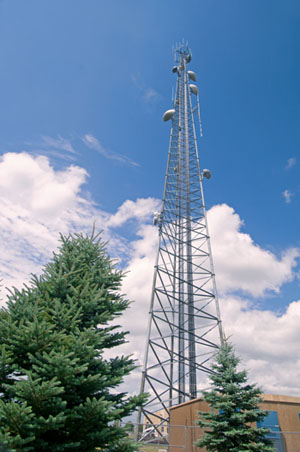By Beth Petrowske

Plans call for 327 radio towers to be built about 20-miles apart throughout Minnesota to handle ARMER radio traffic. Photo by David Gonzalez
|
By the end of December, all Mn/DOT radios will be connected to the Allied Radio Matrix for Emergency Response network—an interoperable radio communications system that allows Mn/DOT, the Department of Public Safety, law enforcement and other public agencies to communicate more effectively with each other, especially during an emergency.
“With the ARMER system, all participants are able to communicate from anywhere in the state with anybody else connected to the system,” said Mark Gieseke, Electronic Communications director.
Previous to the implementation of the ARMER system there were few common frequencies for radio communications, resulting in regular communication breakdowns between public safety responders during emergencies.
Metro District has been using the ARMER system since 2002 and has benefited from its effectiveness, according to Gieseke.
“ARMER allowed Mn/DOT emergency response personnel to communicate seamlessly among themselves and with other emergency responders after the Interstate 35W Bridge collapse and during the Republican National Convention,” Gieseke said. “ARMER also has proven to be very effective for typical day-to-day communications.”
Development of the ARMER system began in the late 1990s. The terrorist attacks of Sept. 11, 2001, gave national attention to the need for a unified, reliable radio communications system. In addition, the Federal Communications Commission set a 2012 deadline for all VHF band radios to be narrowbanded, meaning many agencies with older equipment would need to replace their radio systems.
There will eventually be 327 radio towers built about 20 miles apart throughout Minnesota to handle ARMER radio traffic. Sixty percent of the towers already have been built—the remaining 40 percent will be completed by 2013. The towers are designed to be shared with other public safety agencies and can be leased to private businesses, including cell phone companies.
Mn/DOT owns and operates the ARMER system for the state of Minnesota. The system is used by more than 40,000 radio subscribers today and will eventually serve at least twice that number, according to Gieseke. Subscribers on the system include:
- State agencies
- City and county law enforcement
- Fire departments
- Emergency medical service providers
- Public works departments
- Emergency management officials
- Transit providers
There are 70 counties, and local governments within those counties, currently planning to migrate to ARMER, which is a voice-only communications system.
“The ARMER system was developed because voice communication is the most critical form of communication in emergency situations,” Gieseke said. “The next step to improving statewide communications will be the development of an interoperable data system that will provide emergency responders with the tools they need to share data files, video and text messages.”
For more information about the ARMER system, visit http://www.srb.state.mn.us/. |



